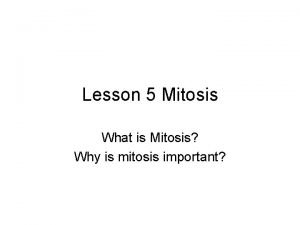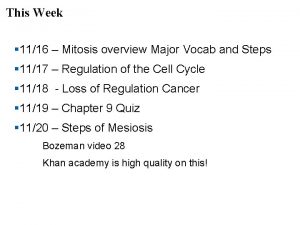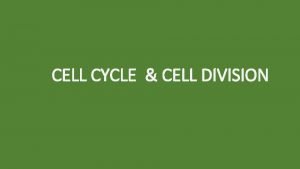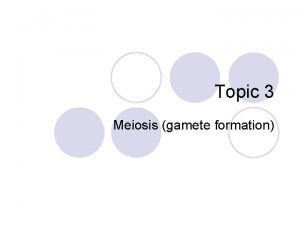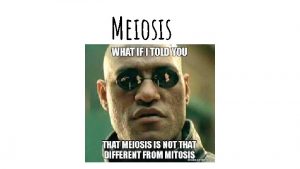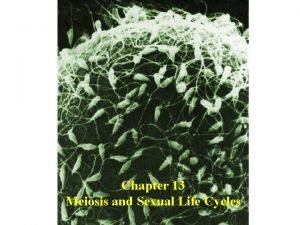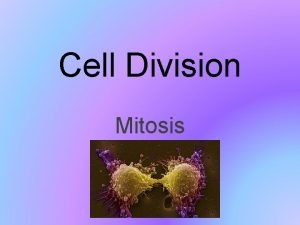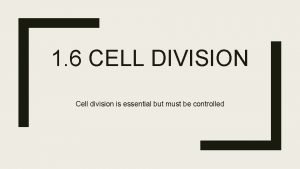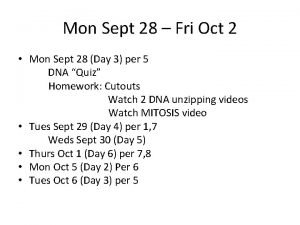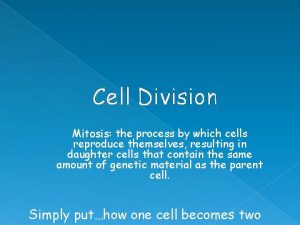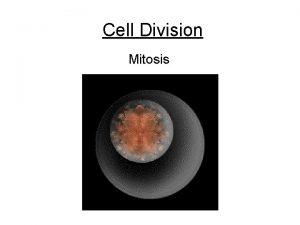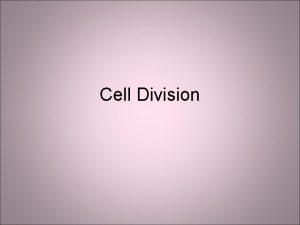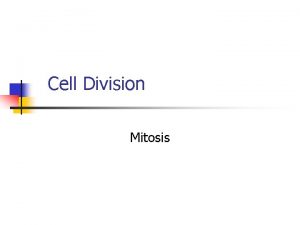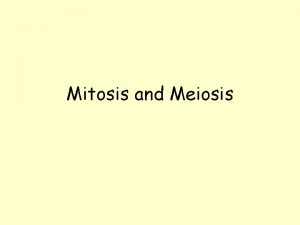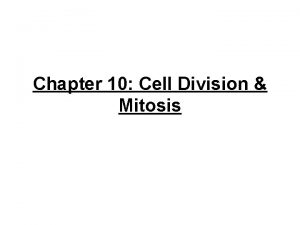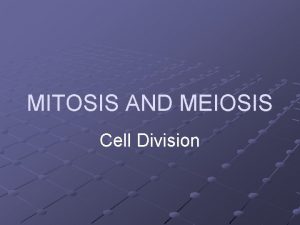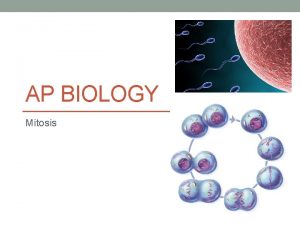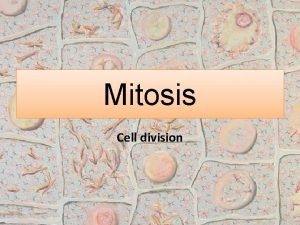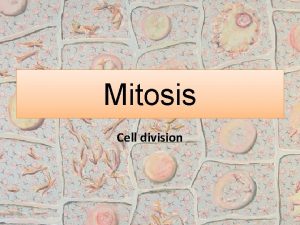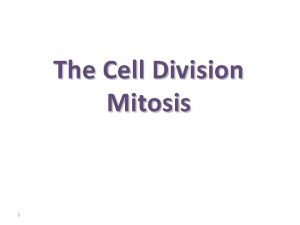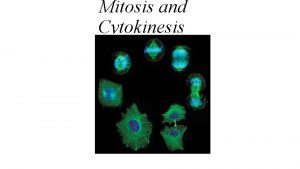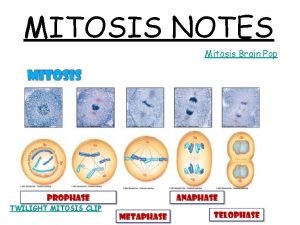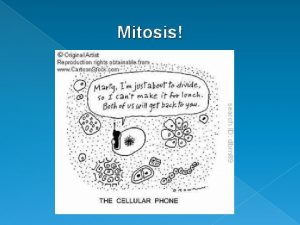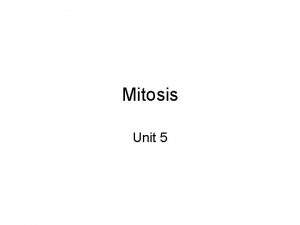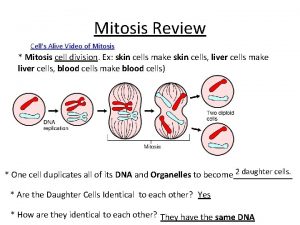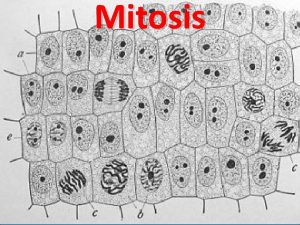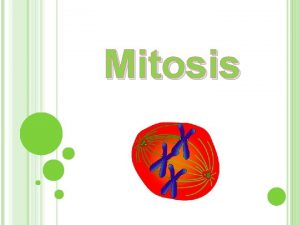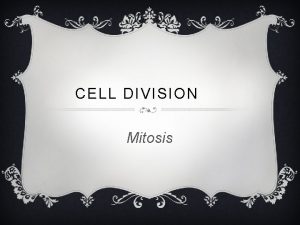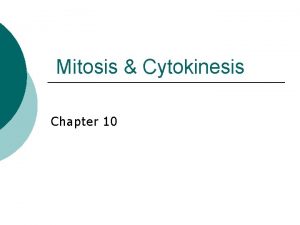Mitosis Cell Division Why Cell Division is Important
























- Slides: 24

Mitosis Cell Division

Why Cell Division is Important: • Dead and damaged cells must be replaced. • Every second million of cells are injured in your body. Your cells must reproduce to replace the old ones • Cells must divide or reproduce.

• Cells do not simply get bigger. • It is important that essential materials be able to enter and leave the cell easily through the membrane. • As the cell grows bigger, the distance between the cell membrane and the nucleus gets larger. • The distance to and from the nucleus must be kept short.

The Cell Cycle



• http: //www. youtube. com/watch? v=vw 1 q. Gt. VR 5 l I&feature=related

INTERPHASE • The resting stage of the cell. • The cell grows. • Just before mitosis, nucleus prepares itself for division by making copies of its chromosomes. • Chromosomes thicken. • Centrioles move to opposite ends of the cell.

PROPHASE • Nuclear membrane disappears. • Chromosomes pair up. • Spindle fibres are formed from centrioles (centrosomes in plants; centrosomes also give rise to centrioles in animals)

METAPHASE • Chromosomes are attached to spindle fibres • Chromosomes pair up and line up at the equator of the cell.

ANAPHASE • Fibres shorten and pull the chromosomes towards the centrioles.

TELOPHASE • Nucleus reforms (1 in each new cell). • Spindle fibres disappear. • Cell prepares for division

CYTOKINESIS • “Cell Motion”. • Cytoplasm divides. • 2 daughter cells form. They contain identical genetic information as mother cell.


anaphase prophase telophase metaphase interphase

Video Examples • http: //www. youtube. com/watch? v=DD 3 IQkn. CEdc&feat ure=related • Ridiculous: http: //www. youtube. com/watch? v=JHRBJgq 50 dk • 3 D: http: //www. youtube. com/watch? v=VGV 3 fv-u. ZYI • Cool Real Time: http: //www. youtube. com/watch? v=m 73 i 1 Zk 8 EA 0&feat ure=related • Creative Rap: http: //www. youtube. com/watch? v=1 NXx. H 56 m. EUA

The Cell Cycle Type of Body Cell Average Life Span Brain 30 -50 years Red Blood 120 days Stomach lining 2 days Liver 200 days Intestine lining 3 days Skin 20 days • Some types of cells must be “encouraged” to divide, while others must be “encouraged” to remain as they are. • Proteins and other molecules carry signals about cells’ health and abundance to control the cell cycle

Cell Cycle – 2 Stages Cytokinesis A B A – Cell Division B – Interphase: • Cells do whatever activities they are designed to do. • Ex. A muscle cell might produce proteins for muscle contraction. • The cell uses oxygen and glucose, releases energy and removes waste. • DNA replicates in prep for cell division.

Checkpoints • Timing and rate of cell division is controlled and monitored • Specialized proteins act like stop signs • STOP!: 1) There are not enough nutrients to support cell growth 2) The DNA has not replicated 3) The DNA is damaged

Cell Cycle – 2 Stages Cytokinesis A B A – Cell Division B – Interphase Cells are destroyed or repaired!

Cell Death • When cells become old or damaged (by physical forces or exposure to toxic chemicals), they leave the Cell Cycle • Contents leak out, irritating surrounding cells

Cell Suicide • Pre-programmed cell death • Contents of cells are saved, packaged and redistributed so other cells can use them Specialized protein

Cancer • Cancer: Cells with abnormal genetic material that are dividing uncontrollably and can spread to other body parts • Start out normal, transformed, ignore stop signs and divide excessively to form a tumour (abnormal clump of cells) further mutations can become cancer • Bad because it fills up the space that should be filled with normal cells performing normal functions (and use nutrients!)

Cancer continued • Many types of mutations. Ex. Ignore programmed suicide, telomerase (enzyme which signals cells don’t have to stop dividing), division even when not attached to a surface (can lead to spread) • Causes: Chance, inherited, contact with mutagens/carcinogens (e. g. asbestos, tobacco smoke, HPV)
 Interphase of cell cycle
Interphase of cell cycle Purpose of mitosis
Purpose of mitosis Andreas carlsson bye bye bye
Andreas carlsson bye bye bye Mitosis and meiosis
Mitosis and meiosis Cell division mitosis and meiosis
Cell division mitosis and meiosis Mitosis cell division
Mitosis cell division Painting
Painting Cell cycle and cell division
Cell cycle and cell division Cell cycle and cell division
Cell cycle and cell division Cell cycle and cell division
Cell cycle and cell division Dont ask
Dont ask From most important to least important in writing
From most important to least important in writing Inverted pyramid in news writing
Inverted pyramid in news writing Least important to most important
Least important to most important Significant of mitosis
Significant of mitosis Mitosis division
Mitosis division Chromosomes human
Chromosomes human Mitosis division
Mitosis division Human development cycle
Human development cycle Ipmat meiosis
Ipmat meiosis Prophase spindle fibers
Prophase spindle fibers Pembelahan sel
Pembelahan sel Cancer is mitosis gone wild
Cancer is mitosis gone wild 2 mon
2 mon How do you know
How do you know

